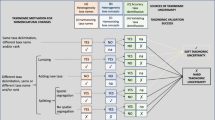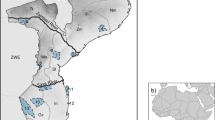Abstract
International databases and data aggregators on species conservation status are powerful tools supporting the efforts of conservation biologists and practitioners in reducing the loss of biodiversity. However, out-of-date information and poor interoperability of databases can hamper conservation of highly threatened species or in extreme cases can result in their removal from conservation frameworks. Lack of common standards for database updates, slow update timing and incongruencies among datasets in terms of taxonomy, threats, conservation status and holding prevent proper conservation prioritization and actions. A simple survey to solve incongruencies between the BGCI PlantSearch Database and the IUCN Red List resulted in a change of status of 16 plant species, including the ‘rehabilitation’ of 12 species thought to be extinct.
This is a preview of subscription content, access via your institution
Access options
Access Nature and 54 other Nature Portfolio journals
Get Nature+, our best-value online-access subscription
$29.99 / 30 days
cancel any time
Subscribe to this journal
Receive 12 digital issues and online access to articles
$119.00 per year
only $9.92 per issue
Buy this article
- Purchase on Springer Link
- Instant access to full article PDF
Prices may be subject to local taxes which are calculated during checkout
Similar content being viewed by others
References
Scheffers, B. R., Yong, D. L., Harris, J. B. C., Giam, X. & Sodhi, N. S. The world’s rediscovered species: back from the brink? PloS ONE 6, e22531 (2011).
Abeli, T., Albani Rocchetti, G., Barina, Z., Bazos, I. & Draper, D. et al. Seventeen ‘extinct’ plant species back to conservation attention in Europe. Nat. Plants 7, 282–286 (2021).
Guidelines for Using the IUCN Red List Categories and Criteria Version 14 (IUCN Standards and Petitions Committee, 2019); http://www.iucnredlist.org/documents/RedListGuidelines.pdf
Dalrymple, S. E. & Abeli, T. Ex situ seed banks and the IUCN Red List. Nat. Plants 5, 122–123 (2019).
Albani Rocchetti, G. et al. Selecting the best candidates for resurrecting extinct-in-the-wild plants from herbaria. Nat. Plants. https://doi.org/10.1038/s41477-022-01296-7 (2022).
The IUCN Red List of Threatened Species Version 2022-1 (IUCN, accessed 264 October 2022); https://www.iucnredlist.org
Humphreys, A. M., Govaerts, R., Ficinski, S. Z., Lughadha, E. N. & Vorontsova, M. S. Global dataset shows geography and life form predict modern plant extinction and rediscovery. Nat. Ecol. Evol. 3, 1043–1047 (2019).
Knapp, W. M., Frances, A., Noss, R., Naczi, R. F. & Weakley, A. et al. Vascular plant extinction in the continental United States and Canada. Conserv. Biol. 35, 360–368 (2021).
Sasidharan, N. Cynometra beddomei. The IUCN Red List of Threatened Species 2020 (IUCN, accessed 27 October 2021); https://www.iucnredlist.org/species/31184/115932185
Cronk, Q. C. B. A new species and hybrid in the St Helena endemic genus Trochetiopsis. Edinb. J. Bot. 52, 205–213 (1995).
Loizeau, P. A. & Jackson, P. W. World Flora Online mid-term update. Ann. Missouri Bot. Gard. 102, 341–346 (2017).
Edwards, C., Bassüner, B., Birkinshaw, C., Camara, C. & Lehavana, A. et al. A botanical mystery solved by phylogenetic analysis of botanical garden collections: the rediscovery of the presumed-extinct Dracaena umbraculifera. Oryx 52, 427–436 (2018).
MosaChristas, K., Karthick, R., Kowsalya, E. & Jaquline, C. R. I. Musa kattuvazhana (Musaceae): rediscovery and additional notes on a critically endangered species from Western Ghats of Tamil Nadu, India. Feddes Repert. 132, 263–268 (2021).
Van Hoi, Q. U. A. C. H., Doudkin, R. V., Cuong, T. Q., Le Van, S. O. N. & Van Dung, L. U. O. N. G. et al. Rediscovery of Camellia langbianensis (Theaceae) in Vietnam. Phytotaxa 480, 85–90 (2021).
Wilkinson, M. D., Dumontier, M., Aalbersberg, I. J., Appleton, G. & Axton, M. et al. The FAIR guiding principles for scientific data management and stewardship. Sci. Data 3, 160018 (2016).
Costello, M. J. & Wieczorek, J. Best practice for biodiversity data management and publication. Biol. Conserv. 173, 68–73 (2014).
Wieczorek, J., Bloom, D., Guralnick, R., Blum, S., Döring, M., Giovanni, R., Robertson, T. & Vieglais, D. Darwin Core: an evolving community-developed biodiversity data standard. PloS ONE 7, e29715 (2012).
de Lange, P.J. Lepidium obtusatum Fact Sheet (content continuously updated) (New Zealand Plant Conservation Network, accessed 16 December 2021); https://www.nzpcn.org.nz/flora/species/lepidium-obtusatum/
Knapp, W.M., Poindexter, D.B. & Weakley, A.S. The true identity of Marshallia grandiflora an extinct species and the description of Marshallia pulchra (Asteraceae Helenieae Marshalliinae). Phytotaxa 447, 1–15 (2020).
Acknowledgements
We thank all botanic gardens that provided useful data for this research.
Author information
Authors and Affiliations
Contributions
T.A. and G.A.R. conceived the idea and wrote the manuscript. S.S. provided BGCI data and wrote the manuscript.
Corresponding author
Ethics declarations
Competing interests
The authors declare no competing interests.
Peer review
Peer review information
Nature Plants thanks the anonymous reviewers for their contribution to the peer review of this work.
Additional information
Publisher’s note Springer Nature remains neutral with regard to jurisdictional claims in published maps and institutional affiliations.
Supplementary information
Supplementary Information
Supplementary Table 1.
Rights and permissions
Springer Nature or its licensor (e.g. a society or other partner) holds exclusive rights to this article under a publishing agreement with the author(s) or other rightsholder(s); author self-archiving of the accepted manuscript version of this article is solely governed by the terms of such publishing agreement and applicable law.
About this article
Cite this article
Abeli, T., Sharrock, S. & Albani Rocchetti, G. Out-of-date datasets hamper conservation of species close to extinction. Nat. Plants 8, 1370–1373 (2022). https://doi.org/10.1038/s41477-022-01293-w
Received:
Accepted:
Published:
Issue Date:
DOI: https://doi.org/10.1038/s41477-022-01293-w



